Abstract
This article deals with the question of the extent to which the Teutonic Order, as a clerical order of knights founded during the Third Crusade, succeeded in expressing its self-confidence and identity by means of its seal. The “geographical” area of investigation extends to the bailiwicks of Franconia, Alsace–Burgundy, Lorraine, Austria, An der Etsch and in the mountains (South Tyrol) as well as the so-called Deutschmeistertum, whereby the terms mentioned do not necessarily correspond to the present-day areas of that designation. The time frame is within the Middle Ages. Due to the large number of surviving seals of the Teutonic Order, however, only a small insight from a larger study can be provided here. Selected seals of the Order’s various internal leadership strata are therefore presented, compared and examined to determine whether and to what extent they express a form of self-confidence and identity.
The pictorial and written expressiveness of seals is an important element of medieval communication. Although seals were primarily used to securely seal documents, they also conveyed a certain message from the person who had the seal. Those documents, usually deeds, which were issued in connection with a legal transaction, always had a recipient. The pictorial and written language presented on the seals was intended to convey a clear image of the issuer of the document, reflecting their social status. With regard to the Teutonic Order, it must therefore be questioned with what intention the respective seal images as well as the corresponding inscriptions were chosen, and which order’s own self-image was the basis for the choice of motif. Before a corresponding image and script analysis can be carried out, however, it is first appropriate to discuss and define the term self-confidence and other related terms on the basis of the current state of research in order to create an adequate basis for the seal management of the Teutonic Order.
1. Self-Image of Religious Orders of Knights: Order of St. John, Templars and the Teutonic Order
During the XIII Conference of Ordines Militares in Toruń in 2005, Roman Czaja (2005) reflected on the topic of self-image in religious orders of chivalry, the current state of research and unanswered questions. Although the term itself has been used continuously and frequently in research since the 1950s, it was never based on a uniform definition, and so identity, self-understanding, self-interpretation, self-esteem, mentality and self-confidence were used synonymously. It was not until 1997 that Michael Borgolte began a corresponding discussion, whereby he classified the term “self-image” as the “world orientation of individuals and groups” and that of “mentalities” as a “social aspect”. Although Borgolte differentiates between individuals and groups, Czaja rightly criticizes the fact that the thesis lacks a clear distinction between the concepts of self-understanding, perception of reality and ideas. Czaja’s interpretation should be understood “as Hans-Werner Goetz has noted—as a plea to pay more attention than before to the contrasts and ruptures in human behavior in the history of mentality” and not as a fundamental opposing opinion on the study of self-understanding, its perceptions and ideas. Czaja admits, however, that it is not easy for the historian to make a distinction on the basis of the available source material, but that it always involves a certain speculative element. At this point, it should be noted that the question of spirituality should also be discussed in this context, as it has taken on different forms in different centuries. Due to the changing nature of spirituality, it is not possible to speak of “one” or “the” spirituality. However, a further discussion of this question would go too far at this point, so we refer to André Vauchez (1993), The Spirituality of the Medieval West: The Eighth to the Twelfth Century.
Helen Nicholson (1989)’s dissertation on “Images of the Military Orders 1128–1291” was the first important step towards exploring this topic in relation to the chivalric orders. She used various media, which the knightly orders used to shape and disseminate their self-image, as a source basis. On the one hand, these consisted of written and visual media, but on the other also included “narratives” of the knightly orders, which led to the following findings by Nicholson:
- (1)
- Every religious community strives to project a positive image of itself to the outside world in order to establish and expand its own reputation and the associated scope for action.
- (2)
- Positive and negative criticism from outside the community is important here.
- (3)
- A uniform, internal self-image or identity was fundamental to the lasting and successful survival of an order that spread across large parts of Europe.
A few years after Nicholson, Kaspar Elm (1993) dealt with the topic of “Die Spiritualität der geistlichen Ritterorden des Mittelalters. Forschungsstand und Forschungsprobleme”. In his study, he refers to the three great orders of the Knights of St. John, the Knights Templar and the Teutonic Order, for which he developed the following points as self-defining elements:
- (1)
- Bernard of Clairvaux’s idea of the Knighthood of God.
- (2)
- Hospitalitas and misericordia towards the poor, the sick and pilgrims.
- (3)
- The Holy Land and the Holy Places as important points of reference.
In addition to the areas just mentioned, both Elm and Nicholson see the veneration of the saints of the orders as the most important part of the formation of the corresponding self-confidence, although neither the Knights of St. John, the Knights Templar nor even the Teutonic Knights had a genuine order-specific saint, so that a general veneration of certain saints, such as the Virgin Mary, took place.1 But to what extent is the method used by Nicholson and Elm relevant to the present study?
In principle, it can be assumed that the idea of the Knighthood of God played an important role for knightly orders, although this is not the case for the Teutonic Order. Of the three major knightly orders of the Crusader period, it was only the Knights Templar who internalized, lived and cultivated the Knighthood of God on the basis of Bernard of Clairvaux’s writing Liber ad milites templi de laude novae militiae, which was and is visible to everyone simply through their official title Pauperes commilitones Christi templique Salomonici Hierosolymitanis. In contrast to this were the Knights of St. John and the Teutonic Order, who had emphasized the charitable element since their foundation. This different attitude is also expressed in the seals of the respective superiors of the orders, i.e., those of the Grand Masters of the Knights of St. John, the Knights Templar and the Teutonic Order:
A scene with a strong narrative character was chosen for the seal of the Grand Master of the Knights of St. John.2 The obverse (avers) shows a sick person lying in a hospital with a lamp hanging from the ceiling above his bed, while a holy water vessel is depicted at the foot of the bed and a cross at the head. This scene, especially in combination with the accompanying inscription HOSPITALIS IHERUSALEM, clearly refers to the caring and charitable character of the order. The seal of the Grand Master of the Knights Templar (Figure 1) stands in marked contrast to this. This shows two armored horsemen on a horse, whereby the inscription SIGILLVM MILITVM XPISTI again refers to the inherent character of the Templars. Both heads of the orders thus clearly refer to the guidelines that characterize the orders by means of their seals.
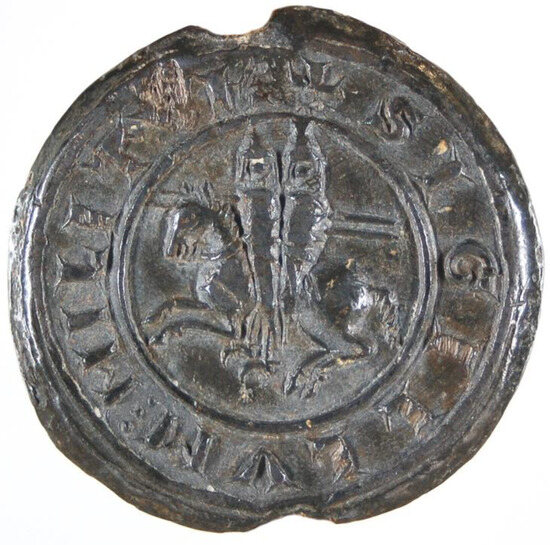
Figure 1.
Seal of the Grand Master of the Templars (27 April 1167), Staatsarchiv Amberg, Kloster Waldsassen, Urkunden 7 (avers).
This leaves us with a look at the Grand Master’s seal of the Teutonic Order (Figure 2), which is not found in either of the two traditions already mentioned. The Order’s leadership therefore opted neither for military and thus secular depictions nor for the charitable element, which can nevertheless be clearly proven based on the Order’s founding history. Instead, an enthroned Mother of God, holding the infant Jesus in her left arm and a lily scepter in her right, forms the central statement of that seal. The Order thus undoubtedly invokes the Mother of God as its supreme patron saint and wishes to emphasize its existence as a follower of the Passion of Christ and Mary. Behind this first clear interpretation lies another interpretation. On closer inspection, the seated group of people on the throne bench bears a strong resemblance to the throne or majesty seals of medieval kings and emperors. However, it should not be assumed that the Teutonic Order wanted to be in line with those rulers. It is much more likely that the Grand Masters wanted to use this imagery to express that their position for the entire Teutonic Order was the same as that held by kings and emperors within the empire.3 This would not only amount to the “elevation of their own rank”, but also, as Manfred Groten (1908) was able to prove for the bishops, manifest the presentation of the claim to power in their own domain. In addition, the effect of the veneration of saints on the self-image of the Teutonic Order, as identified by Nicholson and Elm, would clearly have been achieved through the Christological and Mariological presentation. However, since Mary is not a pure Teutonic Order saint, but was venerated by numerous other ecclesiastical (knightly) orders, it should be explicitly pointed out that her choice as a seal motif is also not specific to the Teutonic Order.4
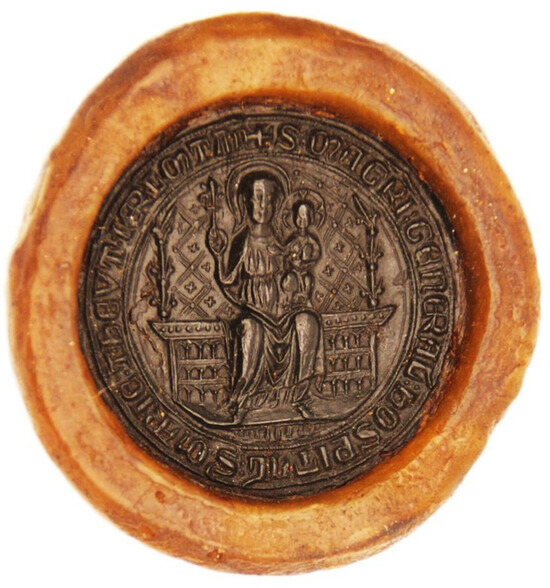
Figure 2.
Seal of the Grand Master of the Teutonic Order (1455). Deutschordenszentralarchiv Wien, 6 October 1455.
The previously mentioned concepts of hospitalitas and misericordia are thus only reflected in the seals just mentioned in the seal of the Grand Master of the Knights of St. John. However, these elements can also be demonstrated for the Teutonic Order, although in this case not at the level of the Grand Master, but rather for individual branches of the Order. Finally, the third point, the reference to the Holy Places and the Holy Land itself, should be mentioned. This can neither be discerned in the imagery of the seals nor in their corresponding inscriptions.5 This should make it clear that the methods described above are only of very limited use for the present study.
Thirdly, in addition to Nicholson and Elm, reference should also be made to Jürgen Sarnowsky (1999), who considered “Das historische Selbstverständnis der geistlichen Ritterorden”. In his study of the identity of the orders of chivalry, Sarnowsky (1998) concentrated on regional, national and universal characteristics that, in his opinion, were fundamental to the formation of a self-image that spanned all orders and thus affected all religious orders of chivalry. These include the following:
- (1)
- The idea of the Gentile war;
- (2)
- The reception of the Old Testament;
- (3)
- The connections to the Holy Land;
- (4)
- The affiliation of the respective members of an order to the clergy;
- (5)
- The combination of chivalric-warrior and spiritual elements;
- (6)
- The aristocratic origin of the order’s members;
- (7)
- The idea of their own sovereignty.
Sarnowsky’s separation of two identities, namely, the group identity for the religious community as such and the individual identity of the individual members of the order, appears to be elementary. This brief overview has shown that Nicholson, Elm and Sarnowsky worked towards the same goal, but chose different methodological approaches to achieve it. As a result, one goal is illuminated from different angles, which can only be an advantage for broad-based research. For the purposes of this article, however, we will mainly draw on Sarnowsky’s findings, as they have the greatest number of similarities in connection with the Teutonic Order.6
In addition to the Christological and Mariological imagery used on the Grand Master’s seals, but also on those of the German Master (Figure 3) or the Land Commander of Franconia (Figure 4), there are few examples of Old Testament scenes. The commander of Alsace–Burgundy, for example, chose the sacrifice of Abraham as his second seal motif, while the commander of Austria (Figure 5) always referred to Samson’s battle with the lion. This also makes it clear that the holders of the seals belonged to the clergy. While even the seal of the Supreme Marshall of the Teutonic Order (Figure 6) also illustrates the knightly and martial element through the armored knight presented there, there is no reference to the aristocratic origin of the Order’s members. This is primarily due to Rule 19 of the Rules and Statutes of the Teutonic Order, according to which it was forbidden for individual office holders, regardless of their hierarchical position, to include any kind of personal feature on the seal.7 However, an increasing softening of this rule can be observed from the middle of the 15th century onwards, as coats of arms were increasingly included, especially on the seals of the German Master (Figure 7) and individual land commanders. In fact, the aspect of sovereignty can also be found in a broader sense on Teutonic Order seals, although this applies predominantly to the Order’s sphere of activity in East Central Europe; the seal of the commandery Horneck (Figure 8) should serve as an example of the Order’s “territory” within the borders of the Empire.
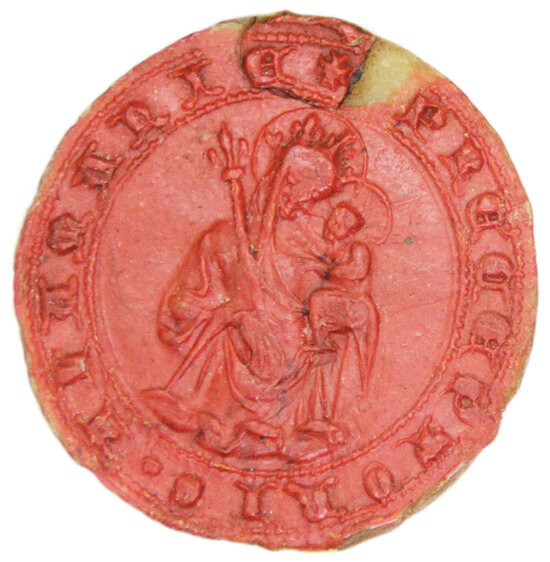
Figure 3.
Seal of the German Master of the Teutonic Order (1367). Deutschordenszentralarchiv Wien, 24 September 1367.
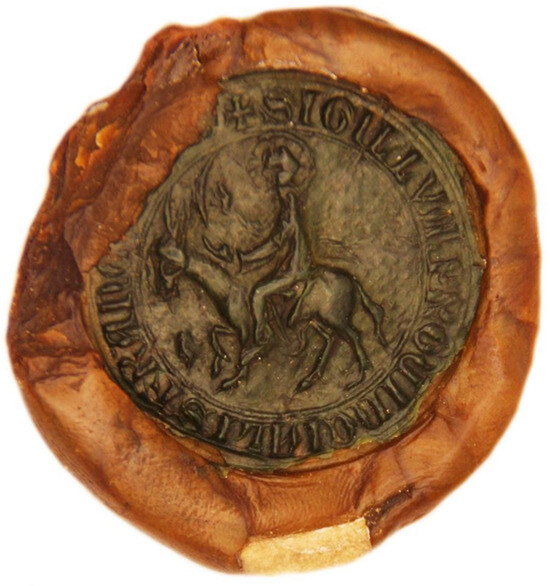
Figure 4.
Seal of the Land Commander of Franconia (1455). Deutschordenszentralarchiv Wien, 11 May 1455.
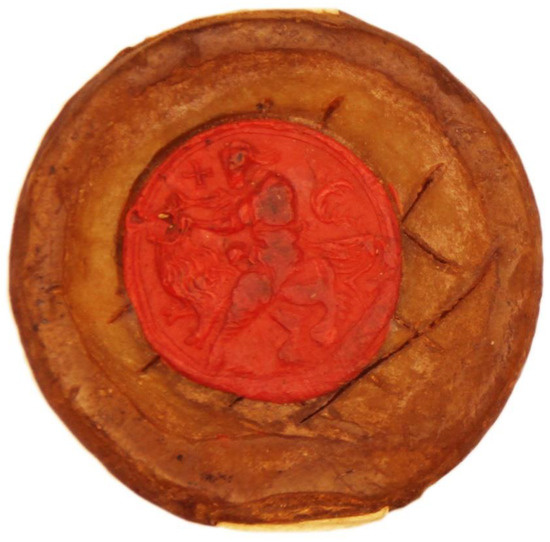
Figure 5.
Seal of the Land Commander of Austria (1335). Deutschordenszentralarchiv Wien, 20 April 1543.
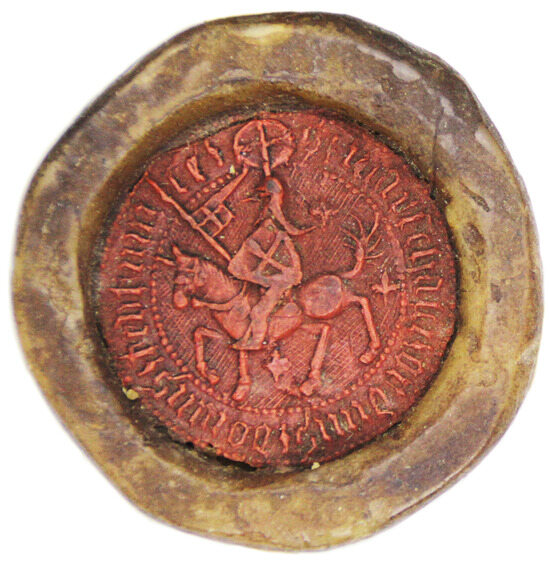
Figure 6.
Seals of the Supreme Marshall of the Teutonic Order (1418). Deutschordenszentralarchiv Wien, 8 November 1418.
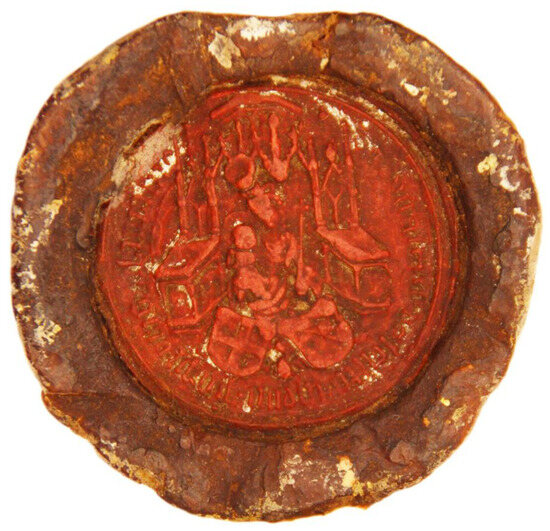
Figure 7.
Seal of the German Master of the Teutonic Order, with coat of arms (1462). Deutschordenszentralarchiv Wien, 28 September 1462.
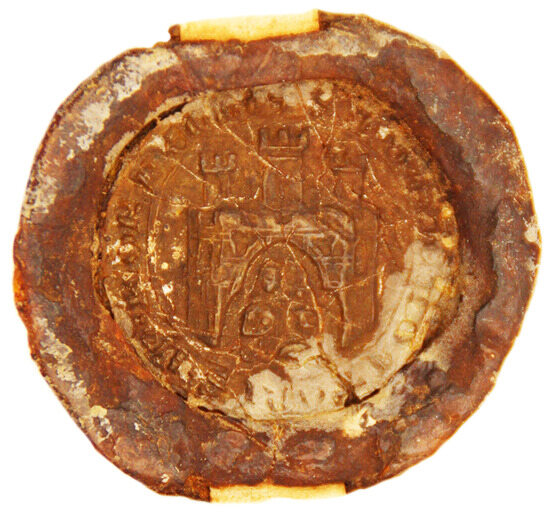
Figure 8.
Seal of the commandery Horneck of the Teutonic Order (1462). Deutschordenszentralarchiv Wien, 28 September 1462.
To conclude this rather general section on self-image and self-conception, the following should be noted: In addition to the aspects mentioned above, the veneration of saints is a particularly important element in the development of the self-confidence of knightly order brothers. In accordance with this, certain saints are preferred, for the Teutonic Order these are, in addition to the Mother of God Mary, Elizabeth (of Thuringia) and George, but according to Udo Arnold these are “no exclusive saint(s)”. As the Mother of God, Mary is in first place, while Elizabeth, who represents the charitable and caring element, and George, who illustrates the military character, share the following places. Overall, there were very clear differences in the self-perception of the Knights of St. John, the Knights Templar and the Teutonic Order. For example, the Knights of St. John strove to venerate their own confreres as saints, but also included the apostles. Meanwhile, the Knights Templar and the Teutonic Order chose the Old Testament as their focal point. Elm also sees a tendency towards regionalism due to the internal orientation of the orders, which is influenced by the local political and social conditions.
2. Self-Image in the Teutonic Order
Although research over the past three decades has increasingly dealt with the topic of the self-image and self-conception of religious orders of chivalry, this has generally been of a more general nature. A study that dealt with just one of the three major knightly orders of the crusade period was only presented by Marcus Wüst (2013), who dealt with the medieval self-image of the Teutonic Order but focused on the brother knights rather than the brother priests. As the Teutonic Order was initially founded as a purely clerical order, it was the brother priests who shaped its nature within the community and its image to the outside world in the first years or decades of its existence. As early as 1198, the order was elevated to the status of an ecclesiastical order of knights, which meant that the military element also found its way into the order, gradually pushing the clerical element further and further into the background.8 As a result of the Knights’ preeminence, which lasted for several centuries, it was also those members of the order who not only influenced its appearance, but naturally also shaped its self-image and self-confidence. For his investigation, Wüst used a wide variety of sources that had an influence on this self-image. These included the aforementioned patron saints of the order, who, in addition to the mission statement, also shaped the ideal values of the community.
However, in order to exist successfully in the long term, every religious community needs a set of rules to guide its members. For the Teutonic Order, this would be the rules and statutes, of which Rule 19 has already been mentioned, as well as the associated Consuetudines, the habits. In addition, a chronological–teleological historiography is used, which not only served to bring past events closer to the confreres, but above all to convey goal-oriented action. This basis can hardly be discerned for the Teutonic Order, as there was no general reference person who could have served as a fixed point due to the absence of a founder.9 Furthermore, Wüst takes up the aspect of spiritual literature, for example, Heinrich von Hesler’s Gospel of Nicodemus or Apocalypse, as well as the Catena Aurea, written by St. Thomas Aquinas, in which he discusses the four Gospels.10 In addition, Wüst also included symbols in his study, which could not only be architectural, but also originate from heraldry or sphragistics. These allow for a separate assessment of the order’s view of itself via the corresponding representation.
Particularly in the context of sphragistics, the representation of the ego in the documents issued by the Order, which mostly have a formulaic, diplomatic character, should also be considered. As a final element of his research, Wüst included the Order’s pagan struggle in connection with its conflict with Poland–Lithuania. The formation of the Polish–Lithuanian Union (1385) as a direct consequence of the marriage between the Polish Queen Hedwig and the Lithuanian Grand Duke Jagiello resulted in the acceptance of the Christian faith by that part of the East Central European population. However, this deprived the Teutonic Order of any legitimacy for missionizing pagans, which in fact did not impress them. Under the pretext that the conversion to Christianity was only a sham argument to avoid missionary work by the Order, it sought to continue its mission, for which it ultimately had to answer at the Council of Constance (1414–1418). The results of Wüst’s research show above all that the self-image of the Teutonic Order had no fixed structures, but was rather subject to permanent change, which was based on the intention to justify the existence of each member of the order as well as that of the entire community, the action or non-action.
Taking into account the wide distribution of the order and its structure, it initially seems questionable whether it is possible to speak of a separate self-image. Given the large number of members, their different areas of responsibility and territorial distribution, it is conceivable that the self-image was also subject to various changes and breaks from region to region, for example, which would raise the question of unity through diversity. In addition to the aforementioned statutes, the central structure of the order, which was based on the Grand Master, should be seen as the basis for this. This interplay was to be largely responsible for the survival of the Teutonic Order in the various regions of (East Central) Europe with their different social, political, societal and economic characteristics over the centuries. The most influential branch of the Order was the Prussian branch, which, however, suffered a severe setback with the defeat at the Battle of Tannenberg and the subsequent First Peace of Thorn (1410), which is often regarded in research as the beginning of the end of the Order’s rule in that region. Basically, Wüst was able to work out various components of the Order’s self-image, which are as diverse as the Order itself:
- (1)
- The communal spiritual life, which is characterized by the statutes and other literature dealing with piety, obedience, fidelity to God and Mary and the pagan struggle, which is important for the religious state.
- (2)
- Life as a follower of Christ, which is demonstrated, among other things, by the running of hospitals. St. Elisabeth of Thuringia, who founded a hospital in the first half of the 13th century, which was given to the Teutonic Order in 1234, is a key example of this. The hospital concept was also the central element in the founding of the Order in 1190 near Acre.
- (3)
- Obedience, which was to be rendered above all to God, the Mother of God Mary and the (High) Master. The bond with Marie was a particularly important element, as the official title of the Ordo fratrum domus sanctae Mariae Theutonicorum Ierosolimitanorum makes clear.
- (4)
- St. George was regarded as a reflection of the military nature of the order, who fought against paganism and the enemies of Christianity as a defender of the true faith.
- (5)
- The symbolic language used by the Order was not only intended to illustrate the Order’s self-image within the community, but also to make this visible to the outside world. External symbols included architecture, seals, flags and coats of arms, which were intended to illustrate the image of an influential order of knights under the protection of the Mother of God. Marienburg Castle on the Nogat River is a prime example of the Order’s sovereignty in Prussia.
But how does Wüst view the findings to date in relation to the use of seals by the Teutonic Order? In addition to the obvious function of sealing a document, seals primarily serve representative purposes and are therefore to be regarded as a means of official symbolic language. Irrespective of whether the seal leader is an individual person or a community, seals express the “pride and claim of the seal leader”. He defines the relationship between the image of the seal and the self-image of the order first of all by a clear increase in the number of Mariological symbols on the seals of the “highest officials of the order”, under which he subsumes first and foremost the Grand Master, then the Grand Commander, the Teutonic Master and the individual regional commanders. At least in the case of the Grand Master and the Teutonic Master, this can be accepted without reservation, whereas this thesis is no longer tenable in the case of the Land Commanders due to the great diversity in motifs. For example, although the commander of Lorraine had the Annunciation of Mary as his first seal motif, this scene was replaced after only 16 years by that of the Maiestas domini, the enthroned Christ. For the bailiwicks of Franconia, Alsace-Burgundy and Austria, it can be stated that these have either Christological or biblical depictions; only the bailiff of the bailiwick An der Etsch und im Gebirge again chose Mariological imagery. This means that the dominance of Mariological themes postulated by Wüst is not tenable for the area under investigation here.
To conclude this section, I would like to briefly refer to the research of Nicholas Youmans (2022). As part of his research project, he dealt with the topic of “Salvation and knightly honor: The identity of the Teutonic Order as reflected in its symbolic actions”. Youmans assumes that, in addition to the aristocratic origins of the knights of the order, their membership of a religious community was also reflected in their actions and thus contributed to the formation of a common identity. He sees the rituals and actions performed as a further development of the actions carried out by the two older knightly orders of the Knights of St. John and the Knights Templar. In contrast to Wüst, however, he includes a less extensive corpus of sources in his considerations; seals are not used at all.
3. From Theory to Practice: Seals as an Identity-Forming Factor in the Teutonic Order
As the theoretical aspect of the investigation of self-image and self-conception has been dealt with so far, it now seems appropriate to examine these theories in practice using a few selected examples of order seals. In this regard, the office of the Deutschmeister will first be taken up again.
The two older objects from 1324 and 1367 show the Mother of God as a half-figure with the infant Jesus in her left arm and a lily scepter in her right hand. Only a few stylistic changes can be discerned here; these mainly concern the crown of the Mother of God, which can only be seen on the younger of the two seals. With regard to the legend of the seal, it should be noted that only the office of the Deutschmeister is mentioned, but not the person himself. The focus was therefore not on the individual, but on the office itself, which corresponds to the aforementioned Rule 19 from the statutes. With the beginning of the 15th century, however, increasing changes can be discerned. These initially relate to the change of side of the infant Jesus, who is now carried in the right arm. The inscription remains unchanged. Further massive changes can be traced back to the 1460s. The presentation of the group of figures has apparently not changed, but they are now framed by a magnificently designed canopy, while at their feet there are now two coats of arms, one of which shows the cross of the Order, the second the coat of arms of the then incumbent Ulrich von Lentersheim. The inscription s[igillum]. udalrici. de. lentersheim. preceptoris alamanie is an additional reference to his person. This is now a clear violation of Rule 19 of the statutes, which is primarily due to the ever-increasing self-confidence of the aristocratic officials. From now on, the individual also stands alongside the community. However, this development is not based on a general change in the religious and social context from the 13th to the 15th century, but rather on changes within the Teutonic Order.
In the order’s internal hierarchy, the office of Deutschmeister was followed by that of Landkomtur, who were responsible for the administration of a bailiwick, i.e., several branches of the order. The first seal for the Land Commander of Franconia can be traced back to the year 1268 and shows the Son of God as the ruler of the world. The depiction is supplemented by the letters A and w, which are presented on either side of the figure and symbolize the beginning and end of Christ’s creation. The inscription S[IGILLUM] P[RE]CEPTORIS FRANCONIE SVEVIE BAYWARIE TEUTON? immediately refers to the office of Landkomtur, to which parts of Swabia and Bavaria were also subject at that time. This seal underwent massive changes, which were expressed above all in the imagery. The focus of the seal was no longer the Son of God as such, but rather a scene from the Passio Christi, namely the entry of Jesus into Jerusalem, which is symbolized by the palm donkey. The inscription was reduced to the + SIG[ILLUM] [PR]OVINCIALIS [FRAN]CONIE. It is not possible to say with absolute certainty what the motivation behind the change in scene was, but it is possible that it was the following of Christ in his suffering, which has a different significance to the depiction of the Judge of the World.
The commanderies of Alsace–Burgundy and Lorraine also used different motifs in their seals. In the middle of the 13th century, the commander of Lorraine opted for the Annunciation of Mary, while by the end of the same century the already familiar scene of the Sovereign of the World was used. The Bailiwick of Alsace–Burgundy did not yet have its own seal in its initial phase, which is why the seal of the Kommende Sundheim had to be used in this case. There is no evidence of a seal until 1288, more than 30 years after the establishment of the bailiwick. The motif chosen here is the crucifixion group, under which there is presumably the kneeling Person of the Landkomtur. Here, the inscription also refers to the bailiwick or the office when it reads + S[IGILLVM] CO[N]MENDATORIS DE ALSACIA ET BVRGUNDIA. No statement can be made about the duration of the use of this motif, but by the end of the 14th century at the latest, a change in scene was also made here. The new motif, which remained in place from then on, now shows an Old Testament scene with the sacrifice of Abraham. The later addition to the coat of arms of the order and the regional commandery is also documented for Alsace–Burgundy.
Compared to the previous holders of office, there is a great deal of continuity for the Landkomtur of Austria with regard to the use of his seal. Even if the artistic design of the seal images was sometimes subject to the fashion of the time, there is always evidence of one and the same motif. Once again, Samson and the lion is a scene from the Old Testament. Finally, reference should be made to the official seal of the district commander of the Ballei An der Etsch und im Gebirge. This seal is unusual in that it is the only one of those mentioned so far that actually has the aforementioned Christological and Mariological reference. Maria Lactans, i.e., the nourishing Mother of God, can also be seen throughout the centuries. This motif is also supplemented in the lower half of the image by the Person of the Landcomtus as an adorant, as is already known from the first seal of the Alsatian–Burgundian Landcomtur. The artistic design became more refined, and from the 16th century onwards, the addition of escutcheons can also be observed. With a few exceptions, these are divided into four parts and show both the cross of the order and the personal coat of arms of the respective office holder. In comparison to the Deutschmeister, where the personal elements were included much earlier, the inscription with + S. PROVINCIAL[IS] BALIE AT[HE]SIS ORD[O] MILICIE S. MARIE ALEMANIER[ORUM] still only refers to the office and not to the person behind it.
4. Summary
These few, but very different seals allow us to draw an initial conclusion with regard to the expression of the self-image and self-image of the Teutonic Order. However, this also raises the question of whether and to what extent the Order succeeded in demonstrating a uniform identity for the Order as a whole through the pictorial language of the seals. According to the current state of knowledge, the following results emerge in this respect:
Of the theories of Nicholson, Elm, Sarnowsky and Wüst, only individual elements can be considered unique to the Teutonic Order’s self-image, as it is more a combination of various factors of the corresponding approaches, which were also valid for other orders, e.g., the Knights of St. John and the Knights Templar.
Rule 19 of the statutes of the Teutonic Order initially severely restricted the use of its seal, as no personal seal or any personal features were permitted on the seals. No such restriction is known for the Order of St. John. As a consequence of this rule, the fallacy could arise that the range of motifs on the Teutonic Order’s seals is not overly diverse. Even if the examples presented here only show a very small selection of those seals, this can be decisively contradicted on the basis of a larger corpus.
From the middle of the 15th century, Rule 19 was repeatedly disregarded and personal elements were added to the previously pure official seals, both in image and in writing. For this purpose, the family coat of arms of the noble family from which the respective official came was used, and the name of the official was occasionally included in the inscription. In addition to the increasing aristocratic self-confidence, which was due to the origin of the Teutonic Masters or Landkomture, it was above all the transformation of the Teutonic Order into “the hospital of the nobility”. The Order became more and more a care institution for the nobility.
The seal of the Grand Master is reminiscent of those of other spiritual and secular rulers. The enthroned Virgin and Child is strongly reminiscent of the throne seals of emperors, kings or bishops.
Including the order’s internal hierarchy, there are Mariological scenes in the sense of the enthroned Mother of God with Child Jesus or the Mother of God with Child in half-length for the office of Grand Master as well as the German Master. Only a few exceptions, which relate to the order’s branches in Altshausen, Friesach and Speyer, also show motifs of this kind outside of this level of leadership. According to current knowledge, only three motifs from the life of Mary herself are known to have been used by the Teutonic Order with its seal: the Annunciation of Mary (Land Commander of Lorraine), the Death of Mary (Vice Land Master of Prussia) and the Coronation of Mary (Grand Commander). Finally, there are scenes dealing with the Passion of Christ, his life and death, motifs from the Bible and depictions of saints. These were predominantly used on the seals of the individual commanderies; differences in the significance of such commanderies cannot be discerned on the basis of the seal motifs, whereas the three Mariological motifs mentioned above were reserved for the higher leadership level of the order.
Although a uniform self-image and understanding was cultivated within the Order as a closed religious community, and the variety of different seal images is unsurpassed, the Teutonic Order did not succeed in making a uniform identity clear by means of the seal images, which at the same time reflected the individuality of the Order. The individual members of the Order are completely disregarded, as only the corporation itself is represented.
Funding
This research received no external funding.
Institutional Review Board Statement
Not applicable.
Informed Consent Statement
Not applicable.
Data Availability Statement
No new data were created or analyzed in this study. Data sharing is not applicable to this article.
Conflicts of Interest
The author declares no conflicts of interest.
Notes
| 1 | Vgl. (Czaja 2005, p.10). For example, the image of the Mother of God is mainly used for the seals of the Cistercians, vgl. (Bony 1987, pp. 210–40). Similar to Bony’s investigation is the investigation of Bolom-Kotari (2015, pp. 332–60). In addition, the publication by Klueting (2014, pp. 547–56) should also be mentioned. |
| 2 | https://museumstjohn.org.uk/seals-of-the-grand-masters/ (accessed on 10 January 2024). |
| 3 | The similarity in the depiction of the throne seals of emperors/kings and the Grand Masters of the Teutonic Order was already noted by Udo Arnold (2020), Das christologisch-mariologische Programm, p. 77. |
| 4 | The veneration of the Virgin Mary on seals can also be proven for the Cistercians, among others, vgl. (Krausen 1950). In comparison to the Teutonic Order, whose rule only stipulated that its brothers were not allowed to use a personal seal and thus only limited the choice of motif, the Cistercian rule clearly stipulated the use of the Virgin Mary for the seal. |
| 5 | The fact that the seal of the Grand Master of the Knights Templar shows a temple on the reverse is not evidence of a reference to the Holy Land, but rather a reference to the founding of the order. |
| 6 | Only the recourse to the idea of pagan warfare and the reference to the Holy Land cannot be proven by the seal of the Teutonic Order. |
| 7 | Vgl. (Perlbach 1890): “Das diekein brûder insigele habe âne die ambethlûte: Wir setzen ouch, daz dekein brûder âne die, den ambeth bevolhen sint, diekein insigel habe noch brieve sende noch die lese, âne des obersten urlop, vor dem man ouch lesen sal die brieve, die gesant sint oder die man wil senden, ob ez im gevellet”. |
| 8 | From then on, the Rule of the Knights Templar played an important role in military affairs, while charitable work was based on the Rule of St. John. |
| 9 | However, the Teutonic Order was not alone in this problem, as the Cistercians and other orders had the same problem. |
| 10 | According to Wüst (2013, pp. 181–82), there is no direct connection between the Teutonic Order and the Gospel of Nicodemus in the sense of a link between the content and the history of the Order. Rather, Wüst sees the connection based on the reception within the Order; according to him, the so-called Stuttgart manuscript that has survived was also in the possession of a brother from the Kommende Giengen. The situation is similar with the Catena Aurea, but the connection to the order is solely due to its reception within the community, see (Wüst 2013, pp. 185–86). |
References
- Arnold, Udo. 2020. Das christologisch-mariologische Programm der mittelalterlichen Deutschordenssiegel. In Peregrinantes Peregrinantibus. 825 Jahre Deutscher Orden, 150 Jahre Ehrenritter, 50 Jahre Familiarenstatut (Quellen und Studien zur Geschichte des Deutschen Ordens 80, hg. v. Udo Arnold and Bernhard Huber). Ilmtal-Weinstraße: VDG. [Google Scholar]
- Bolom-Kotari, Martina. 2015. Die Siegel der mährischen Prämonstratenser als Quelle zur Geschichte der Zirkarie. In Ordenshistoriographie in Mitteleuropa. Gestaltung und Wandlung des institutionalen und persönlichen Gedächtnisses in der Frühen Neuzeit. Referate der gleichnamigen Tagung in St. Pölten von 22. bis 23. September 2014. Monastica Historica 2. Edited by Heidemarie Bachhofer, Kateřina Bobková-Valentová and Tomáš Černušák. Prag: St. Pölten, pp. 332–60. [Google Scholar]
- Bony, Pierre. 1987. An Introduction of Cistercian seals: The Virgin as Mediatrix, then Protectrix on the Seals of Cistercian Abbeys. In Studies in Cistercian Art an Architecture 3. Kalamazoo: Gorgias Press, pp. 201–40. [Google Scholar]
- Czaja, Roman. 2005. Das Selbstverständnis der geistlichen Ritterorden im Mittelalter. Bilanz und Forschungsperspektive. In Selbstbild und Selbstverständnis der geistlichen Ritterorden. Ordines militares. Colloquia Torunensia Historica XIII. Edited by Roman Czaja and Jürgen Sarnowsky. Toruń: Wydawn. Uniw. Mikołaja Kopernika, pp. 7–21. [Google Scholar]
- Elm, Kaspar. 1993. Die Spiritualität der geistlichen Ritterorden des Mittelalters. Forschungsstand und Forschungsprobleme. In Die Spiritualität der Ritterorden im Mittelalter. Ordines militares. Kolloquia Torunensia Historica VII. Edited by Zenon Hubert Nowak. Toruń: Towarzystwo Naukowe w Toruniu, pp. 7–44. [Google Scholar]
- Groten, Manfred. 1908. Das Aufkommen der bischöflichen Thronsiegel im deutschen Reich. In Historisches Jahrbuch 100. München: Verlag Karl Alber, pp. 163–97. [Google Scholar]
- Klueting, Edeltraud. 2014. Das Siegel der Deutschen Provinz der Karmeliten als Vorbild für das große Siegel der Universität Köln. In Fiat volunta tua. Theologe und Historiker—Priester und Professor. Festschrift zum 65. Geburtstag von Harm Klueting am 23. März 2014. Edited by Reimund Haas. Münster: Aschendorff, pp. 547–56. [Google Scholar]
- Krausen, Edgar. 1950. Von der Siegelführung bei den Zisterziensern von Raitenhaslach. Archivalische Zeitschrift 46: 193–95. [Google Scholar] [CrossRef]
- Nicholson, Helen. 1989. Images of the Military Orders, 1128–1291: Spiritual, Secular, Romantic. Leicester: University of Leicester. [Google Scholar]
- Perlbach, Max, ed. 1890. Die Statuten des Deutschen Ordens nach den ältesten Handschriften. Halle/Saale: Max Niemeyer, p. 45, Regel 19. [Google Scholar]
- Sarnowsky, Jürgen. 1998. Identität und Selbstgefühl der geistlichen Ritterorden. In Ständische und religiöse Identitäten. Edited by Stefan Kwiatkowski and Janusz Mallek. Toruń: Wydawn. Uniw. Mikołaja Kopernika, pp. 109–30. [Google Scholar]
- Sarnowsky, Jürgen. 1999. Das historische Selbstverständnis der geistlichen Ritterorden. In Zeitschrift für Kirchengeschichte 110. Stuttgart: W. Kohlhammer, pp. 315–30. [Google Scholar]
- Vauchez, André. 1993. The Spirituality of the Medieval West: The Eighth to the Twelfth Century. Kalamazoo: Gorgias Press. [Google Scholar]
- Wüst, Marcus. 2013. Studien zum Selbstverständnis des Deutschen Ordens im Mittelalter. In morte pagani christianus gloriatur. Quellen und Studien zur Geschichte des Deutschen Ordens 73. Edited by Udo Arnold. Weimar: VDG. [Google Scholar]
- Youmans, Nicholas. 2022. Zwischen Kloster und Hof: Symbolhandlungen des Deutschen Ordens im 13. Jahrhundert. In Kommendenausbau im Heiligen Römischen Reich des 13. Jahrhunderts. Italien, Franken, Preußen und Livland in vergleichender Perspektive. Quellen und Studien zur Geschichte des Deutschen Ordens 88. Edited by Udo Arnold = Veröffentlichungen der Forschungsstelle Deutscher Orden an der Universität Würzburg 4. Edited by Helmut Flachenecker. Ilmtal-Weinstraße: VDG, pp. 187–203. [Google Scholar]
Disclaimer/Publisher’s Note: The statements, opinions and data contained in all publications are solely those of the individual author(s) and contributor(s) and not of MDPI and/or the editor(s). MDPI and/or the editor(s) disclaim responsibility for any injury to people or property resulting from any ideas, methods, instructions or products referred to in the content. |
© 2024 by the author. Licensee MDPI, Basel, Switzerland. This article is an open access article distributed under the terms and conditions of the Creative Commons Attribution (CC BY) license (https://creativecommons.org/licenses/by/4.0/).